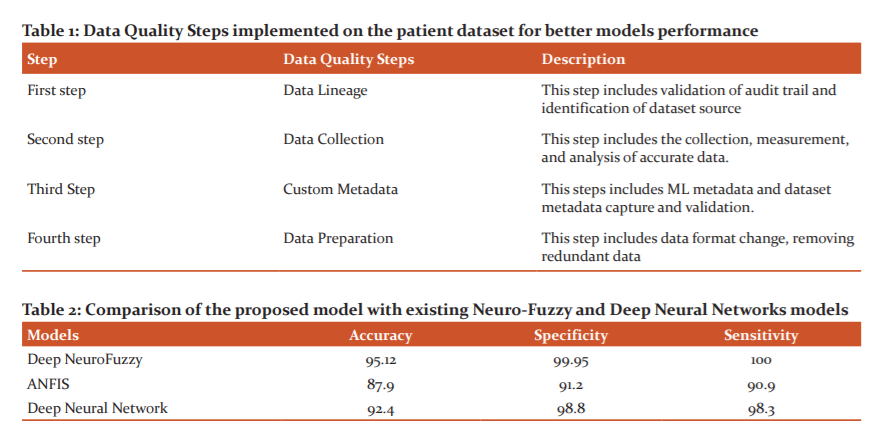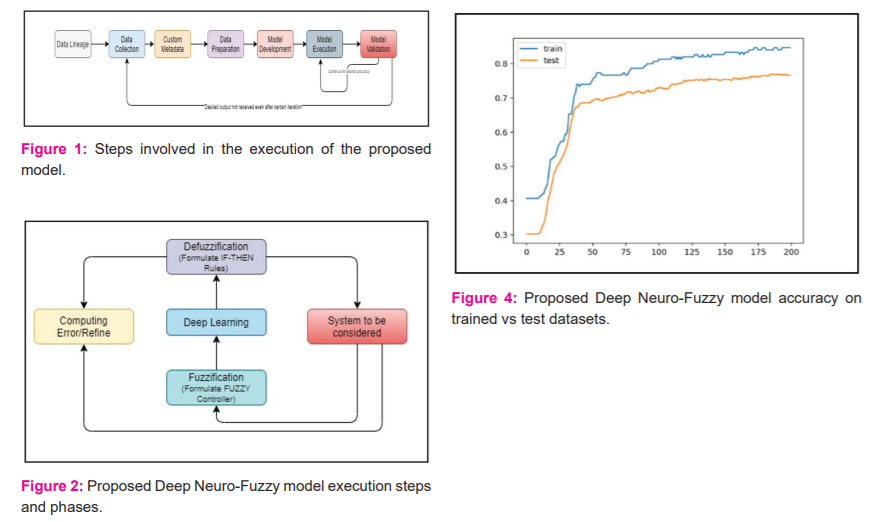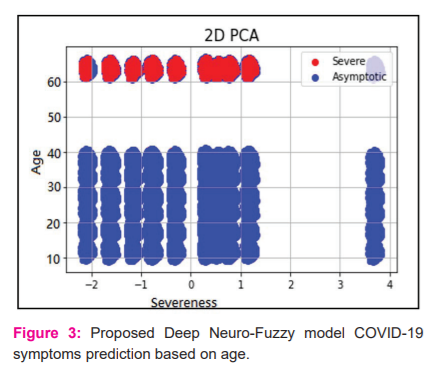IJCRR - 13(20), October, 2021
Pages: 85-89
Date of Publication: 24-Oct-2021
Print Article
Download XML Download PDF
Analysis of COVID-19 Complications Using Deep Learning-Based Neuro-Fuzzy Classification Approach
Author: Modem Amarendhar Reddy, M. James Stephen, P.V.G.D Prasad Reddy
Category: Healthcare
Abstract:Introduction: Nowadays, the use of technology in medical diagnosis, management, and patient care has exploded. Medical diagnosis is a difficult task that is frequently performed by professional developers. This inductive research objective is to investigate advanced machine learning techniques for effectively analyzing health data based on COVID-19 symptoms. There are numerous variables to consider when evaluating the disease, and determining the effect of COVID-19 on various human organs is not an easy task. Objective: This research aims to develop an adaptive medical diagnosis model for COVID-19 to ascertain and predict disease risk and detection. Methods: Frequently used models for classification are Adaptive Neuro-Fuzzy Inference System (ANFIS) and Deep learning-based Neural Networks (DNN). This article employs a Deep Neuro-Fuzzy System with a cooperative structure in its analysis. Results: This article predicts disease using a patient dataset from Mexico with over twenty input parameters or features. To develop a more accurate classification technique, the results of several Deep learning and Neuro-Fuzzy mechanisms are compared and analyzed. This study's outcome can be extended to a larger number of input features and applied to the detection of additional diseases. Conclusion: The proposed Deep Learning-Based Neuro-Fuzzy classification model shows better complications and prediction results compared to others.
Keywords: Artificial Neural Networks, Adaptive Neuro-Fuzzy inference Systems, COVID-19, Deep Learning, Deep Neural Network, Deep Neuro-Fuzzy Systems
Full Text:
INTRODUCTION
Health diagnosis is a difficult task that is often demonstrated by competent engineers. The study will establish a model for adaptive medical diagnosis of COVID-19 to predict and assess disease incidence and detection. There are several factors when determining the disorder, so defining the effects of COVID-19 on various human organs is not an easy task.
Among the numerous machine learning models available, Adaptive Neuro-Fuzzy Inference System (ANFIS) and Deep Neural Network (DNN) are two well-known approaches to data classification. ANFIS is a network that combines fuzzy logic and neural networks. ANFIS has excelled in a variety of fields, including health care and forecasting. One of the challenges with ANFIS is the computational complexity involved in converting data to neural networks. The DNN model learns the features from the training data provided. One of the difficulties with DNN is that it makes predictions opaque and thus difficult to trackback.1, 2
In 2016, A.R.Karthekeyan published a paper describing a technique for increasing the accuracy and speed of processor training classifications by utilising fuzzy neural networks. While neural networks can benefit from data, they cannot be perceived—they are opaque to the human eye. Fuzzy Systems are interpretable but unintelligible language laws. We construct fuzzy data structures using Neural Network Domain Learning algorithms.1 The learning algorithms are capable of studying both fuzzy sets and fuzzy laws, and can also analyse the credit risk before making a bank loan decision. A fuzzy neural network or neuro-fuzzy system is a virtual engine that utilises neural network approximation methods to evaluate consumer information for credit risk management purposes and to identify the parameters of a fuzzy structure ( i.e., fuzzy sets, fuzzy rules). When it comes to bank loan decisions, the Fuzzy Neural network algorithm is all about simplifying the loan officer's role, monitoring it, and increasing performance and profitability.
Sudipta Roy, Shayak Sadhu, Samir Kumar Bandyopadhyay, Debnath Bhattacharyya, and Tai-Hoon Kim proposed a system for rapidly and accurately determining brain tumour type from an image in 2016. The proposed system enables rapid and accurate tumour identification and classification model using the class label. The proposed programme is structured in stages. The initial stage involves normalising an MRI image as input. The next stage entails extracting vectors of features from the image, which eliminates redundant data and provides input to the classifier. For each tuple of extracted vector functions, the classifier generates a classified output. A careful examination of the results demonstrates that our proposed method was extremely efficient and precise.2
In 2020, an advanced adaptive neuro-fuzzy inference system (ANFIS) using enhanced Flower Pollination Algorithm (FPA) and Salp Swarm Algorithm (SSA) was proposed for classification. SSA is used in conjunction with FPA to mitigate some of the FPA disadvantages like being stuck at the local optima). The proposed model, dubbed FPASSA-ANFIS, is centred on the idea of increasing ANFIS efficiency through the use of FPASSA to evaluate ANFIS parameters. The FPASSA-ANFIS model is evaluated by predicting and classification of labels. When compared to other available models, however, the FPASSA-ANFIS model outperforms them in accuracy and execution time. Additionally, they evaluated the model using two datasets and the results indicated an exceptional level of performance.3
Detlef D. Nauck and Andreas N. Urnberger discussed several significant milestones in the evolution of neuro-fuzzy systems.4 According to the paper, the best option for learning predictive models was to combine fuzzy systems and neural networks to create neuro-fuzzy systems. The article discussed the advancements made in the area of combining supervised learning methods and neuro-fuzzy systems.
A deep learning strategy was used to identify COVID-19 by recommending the use of just one see (YOLO) in conjunction with Darknet.5 Their format specified categorising files for COVID-19 by numerical (COVID vs No-Findings) and multi-class (COVID vs No-Findings vs Pneumonia) determinations, resulting in an 87.02 per cent precision. While academics recognised the value of deep learning, it has not been widely applied for realistic implementation in comparison to CBR systems. Additionally, a few experiments demonstrated that cumulative CBR but also deep learning were observed throughout domain acquisition and also the abstraction of attribute weights, even though the former performs the detection task.6-9
The incorporation of fuzzy logic and information gathering techniques was suggested as a way to improve the reaction time and throughput of the extraction phase with a case-based rationale for related offences.6 The fuzzy CBR proposed includes two additional components: a partial for the Fispro determination derived from a fuzzy decision tree and a partial for the case-premised argument advanced via the JColibri model.7 The primary goal of fuzzy logic is to reduce the difficulty associated with determining the level of compatibility between diabetic patients and self-care programmes. The researcher compared the findings to a few existing classification systems that make use of precision indicators such as showings indicators. The experimental results indicate that the fuzzy decision tree appears to be extremely effective at increasing the reliability of the diabetic classification and thus the CBR justification retrieval stage.
Various image classification models using Neuro Fuzzy algorithms were discussed by multiple authors but they haven’t explored using Hybrid Deep Neuro-Fuzzy systems.9-12 Combining fuzzy inference with deep neural networks has been applied to a variety of application areas, including traffic flow prediction and incident prediction.8
MATERIALS AND METHODS
The perspective of the Deep Neuro-Fuzzy model defined and used here is predictive analytics in nature and utilize COVID-19 patient records to improve healthcare quality. Building predictive models from a limited patient data set are incredibly difficult. Our research focuses on the prediction and prevention of COVID-19 disease by using a novel Deep Neuro-Fuzzy model. COVID-19 disease prediction is complicated by their complications and the patient's other comorbidities. There has been some recent work on COVID-19 predictive analysis, but all of it has relied on Neuro-Fuzzy algorithms or Deep learning. We developed a novel Deep Neuro-Fuzzy algorithm that combines the benefits of Neuro-Fuzzy and Deep Neural's network multi-layered structure. The flow diagram shows the overall steps taken to shape the methodology in Figure 1.
Due to the inconsistency of the patient's real-world data, passing the same data to the model may result in the error output. As a result, the data's quality must be preprocessed to ensure maximum accuracy. Data quality preprocessing entails the following steps: data lineage, data collection, custom metadata, and data preparation. Table 1 provides additional information about the data quality steps. The dataset used in this study is the COVID-19 patient data from Mexico with complications. The dataset contains 3,23,323 rows of data containing 25 features gathered from Google's research department.
After data preparation data, it was partitioned as training and testing datasets. Throughout this study, 70% of the dataset instances were chosen for the training and 30% for the testing. Additional testing datasets result in more efficient and reliable results when the proposed model is used.
ANFIS was first introduced by Jang with the integration of Fuzzy Logic(FL) and Artificial Neural Networks.14 Deep Neural Network learns the mapping from the datasets by calculating the weights of each neuron using error backpropagation.9-12
The Deep Neuro-Fuzzy model is composed of fuzzification, deep learning, and defuzzification components. These three components will be executed sequentially. The input layer will read data from the dataset, while the network will carry information about the three components. The Fuzzification component applies the fine-tuned data after preprocessing to the model, where each input xi in this layer is an adaptive Member Function that generates the membership degree. This component converts crisp values to a degree of fuzzy membership. The parameters in this component are trained by the optimization algorithm Gradient Descent(GD). The component devoted to deep learning is the most vital in this model. For deep learning's high level of abstraction, it processes data with a large number of input features. This component is initialised via the Fuzzification component's output. This component feeds fuzzy input signals forward to one of its hidden layers. The nodes in the hidden layer are connected in such a way that processed data is feed-forward to the next layers. The input elements are multiplied by the weight connections that correspond to them. This component makes use of a sigmoid activation function.13,14,15 The final component of the model is defuzzification. The deep learning component extracts and learns features from the dataset, which is then processed by the demulsifier, which generates the model's output. The output is determined by the fuzzy rules that were defined. The Deep Neuro-Fuzzy model is represented in Figure 2.
RESULTS AND DISCUSSION
After building the model according to the proposed methodology, we used an arbitrary slice as input to evaluate the model's effectiveness at classifying the slice into the class marks defined in the training dataset. The model's suggested technique has been implemented and validated in MATLAB. Twenty different types of labels are considered in this case, and the model is properly trained using the training data. Following training, the test dataset constructed from the input slice is compared to it. To determine the effectiveness of the classifier, the prediction is compared to the actual. With the test dataset, the built model achieves an accuracy of 97.1 per cent and a valid accuracy of 95.12 per cent, with a sensitivity of 100 per cent and a specificity of 99.95 per cent. Figures 3 and 4 depict the model's data visualisation and accuracy graph when training and testing data are used. Figure 3 shows the distribution of the patients’ data according to the severity of the disease. Red means severe and blue means asymptotic.
Additionally, experiments on the same dataset were conducted using ANFIS and DNN to compare the results to the Deep Neuro-fuzzy model. As shown in Table 2, the performance of the Deep Neuro-fuzzy model is better than that of the ANFIS and DNN.
CONCLUSION
Our approach is an advanced classifier that has been validated using a Deep Neuro-Fuzzy model for Covid-19 patient complications. On the collected dataset, the classifier achieved an accuracy of 97.1 per cent. It demonstrated the importance of function sub-selection. The function extraction process entails reducing the number of resources required to accurately represent a large range of data. Testing with a large number of variables typically requires a lot of memory and computational resources, or a classification algorithm that consistently matches the training sample and frequently generalises well to new samples. Extraction of features is a broad term that refers to techniques for constructing variable combinations that circumvent these issues while still accurately representing the data.
In this study, we attempted to use feature-rich datasets to conduct preliminary experiments. Additionally, a larger number of input features can be considered in the future. As a result, this model can be used for more than just classification problems and diseases in the future.
ACKNOWLEDGEMENTS
The authors acknowledge the immense help received from the scholars whose articles are cited and included in references of this manuscript. The authors are also grateful to authors/editors/publishers of all those articles, journals and books from where the literature for this article has been reviewed and discussed.
SOURCE OF FUNDING
This is a self-funded project
CONFLICTS OF INTEREST
There are no undisclosed conflicts of interest for the Authors.
AUTHOR CONTRIBUTION
M Amarendhar Reddy - 1) Analysis, design, implementation of the proposed model; 2) Conception and interpretation of dataset; 3) drafting the article, intellectual content review of the article; and 4) final version approval for publication
Dr. M.James Stephen - 1) Conception and design; 2) Intellectual content review of the article, and 3) final version approval for publication
Dr P.V.G.D Prasad Reddy - 1)Intellectual content review of the article; and 2) final version approval for publication.



References:
-
Karthikeyan AR. Fuzzy Neural Network Based Extreme Learning Machine Technique In Credit Risk Management. Int J Adv Res Basic Engg Sci Tech. 2016;19(2);100-107.
-
Sudipta R, Shayak S. Brain Tumor Classification using Adaptive Neuro-Fuzzy Inference System from MRI. Int J Bio-Sci Bio-Tech. 2016;8(3);203-218.
-
Mohammed AA, Ahmed A. Ewers. Optimization Method for Forecasting Con?rmed Cases of COVID-19 in China. J Clin Med. 2020;9(3);674.
-
Nauck DD, Nurnberger A. Neuro-fuzzy systems: A short historical review. Studies in Comp. Int J Interact Multimed. 2013; 91–109.
-
Benamina M, Atmani B, Benbelkacem S. Diabetes diagnosis by case-based reasoning and fuzzy logic. Int J Interact Multimed. 2018;5(3);72-80.
-
Kamran Kowsari. FSL-BM: Fuzzy Supervised Learning with Binary Meta-Feature for Classi?cation. Future of Inf. Com. Conf. (FICC). 2018.
-
Sayed AE, Dahshan A, Badeeh MA, Salem TH. Younis. A hybrid technique for automatic MRI brain images classification. StudiaUniv, Babes Bolyai. Informatica. 2009; 24(1);55-67.
-
Gladis VP, Rathi P, Palani S. Brain Tumor MRI Image Classification with Feature Selection and Extraction Using Linear Discriminant Analysis. Int J Inf Sci Tec. 2012;2(4);131-146.
-
Zacharaki, S. Wang, S. Chawla, D. S. Yoo, R. Wolf, E. R. Melhem, C. Davatzikos. MRI-based classification of brain tumour type and grade using SVM-RFE. IEEE Int. Symp Biomed Imaging. 2009;1035-1038.
-
Evangelia I. Zacharaki, Sumei Wang, Sanjeev Chawla, Dong Soo Yoo, Ronald Wolf, Elias R. Melhem, Christos Davatzikos. Classification of brain tumour type and grade using MRI texture and shape in a machine learning scheme. Nat Inst health. 2009;62(6);1609-1618.
-
M. Fatehi, H. H. Asadi. Application of semi-supervised fuzzy means method in clustering multivariate geochemical data, a case study from the Dalli cu-au porphyry deposit in central Iran. Ore Geology Rev. 2017;81(1);245–255.
-
Y. H. Liu, M. Muftah, T. Das, L. Bai, K. Robson, D. Auer. Classification of MR Tumor Images Based on Gabor Wavelet Analysis. J Med Bio Engg. 2011;32(1);22-28.
-
R.Das, S. Sen, U. J. A. C. S. Maulik. A Survey on Fuzzy Deep Neural Networks. ACM Comp. Surveys. 2020; 53(3);1-25.
-
J. R. Jang. ANFIS: adaptive-network-based fuzzy inference system. IEEE Tran. on Sys. Man Cyb. 1993;23(3);665-685.
-
Mohd Najib Mohd Salleh, Noureen Talpur, Kashif Hussain Talpur. A modified neuro-fuzzy system using metaheuristic approaches for data classification. Intech Open. 2018;29-45.
|






 This work is licensed under a Creative Commons Attribution-NonCommercial 4.0 International License
This work is licensed under a Creative Commons Attribution-NonCommercial 4.0 International License